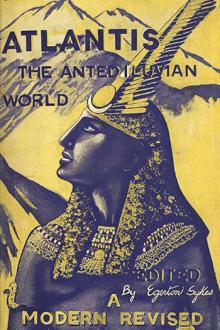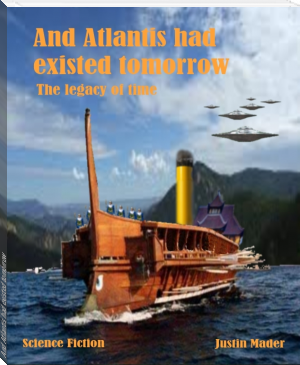Atlantis: The Antedeluvian World by Ignatius Donnelly (thriller novels to read .TXT) 📕

- Author: Ignatius Donnelly
- Performer: -
Book online «Atlantis: The Antedeluvian World by Ignatius Donnelly (thriller novels to read .TXT) 📕». Author Ignatius Donnelly
(Humboldt’s “Cosmos,” vol. ii., 238.)
If they came “from the West” they could not have come from Ireland; and the Scandinavians may easily have mistaken Atlantean books and bells for Irish books and mass-bells. They do not say that there were any evidences that these relics belonged to a people who had recently visited the island; and, as they found the island uninhabited, it would be impossible for them to tell how many years or centuries had elapsed since the books and bells were left there.
The fact that the implements of the Bronze Age came from some common centre, and did not originate independently in different countries, is proved by the striking similarity which exists between the bronze implements of regions as widely separated as Switzerland, Ireland, Denmark, and Africa. It is not to be supposed that any overland communication existed in that early age between these countries; and the coincidence of design which we find to exist can only be accounted for by the fact that the articles of bronze were obtained from some sea-going people, who carried on a commerce at the same time with all these regions.
CELTSCompare, for instance, these two decorated bronze celts. the first from Ireland, the second from Denmark; and then compare both these with a stone celt found in a mound in Tennessee, given below. Here we have the same form precisely.
LEAF SHAPED BRONZE SWORDSCompare the bronze swords in the four preceding illustrations-from Ireland, Sweden, Switzerland, and Denmark-and then observe the same very peculiar shape—the leaf-shape, as it is called—in the stone sword from Big Harpeth River, Tennessee.
We shall find, as we proceed, that the Phœnicians were unquestionably identified with Atlantis, and that it was probably from Atlantis they derived their god Baal, or Bel, or El, whose name crops out in the Bel of the Babylonians, the Elohim, and the Beelzebub of the Jews, and the Allah of the Arabians, And we find that this great deity, whose worship extended so widely among the Mediterranean races, was known and adored also upon the northern and western coasts of Europe. Professor Nilsson finds traces of Baal worship in Scandinavia; he tells us that the festival of Baal, or Balder, was celebrated on midsummer’s night in Scania, and far up into Norway, almost to the Loffoden Islands, until within the last fifty years. The feast of Baal, or Beltinne, was celebrated in Ireland to a late period. I argue from these facts, not that the worship of Baal came to Ireland and Norway from Assyria or Arabia, but that the same great parent-race which carried the knowledge of Baal to the Mediterranean brought it also to the western coasts of Europe, and with the adoration of Baal they imported also the implements of bronze now found in such abundance in those regions.
The same similarity of form exists in the bronze knives from Denmark and Switzerland, as represented in the illustrations on p. 254.
In the central figure we have a representation of an Egyptian-looking man holding a cup before him. We shall see, as we proceed, that the magnetic needle, or “mariner’s compass,” dates back to the days of Hercules, and that it consisted of a bar of magnetized iron floating upon a piece of wood in a cup. It is possible that in this ancient relic of the Bronze Age we have a representation of the magnetic cup. The magnetic needle must certainly have been an object of great interest to a people who, through its agency, were able to carry on commerce on all the shores of Europe, from the Mediterranean to the Baltic. The second knife represented above has upon its handle a wheel, or cross surrounded by a ring, which, we shall see here after, was pre-eminently the symbol of Atlantis.
If we are satisfied that these implements of bronze were the work of the artisans of Atlantis—of the antediluvians—they must acquire additional and extraordinary interest in our eyes, and we turn to them to earn something of the habits and customs of “that great, original, broad-eyed, sunken race.”
We find among the relies of the Bronze Age an urn, which probably gives us some idea of the houses of the Atlanteans: it is evidently made to represent a house, and shows us even the rude fashion in which they fastened their doors. The Mandan Indiana built round houses very much of this appearance.
The museum at Munich contains a very interesting piece of pottery, which is supposed to represent one of the lake villages or hamlets of the era when the people of Switzerland dwelt in houses erected on piles driven into the bottom of the lakes of that country. The accompanying illustration represents it. The double spiral ornament upon it shows that it belongs to the Bronze Age.
Among the curious relies of the Bronze Age are a number of razor-like knives; from which we may conclude that the habit of shaving the whole or some part of the face or head dates back to a great antiquity. The illustrations below represent them.
These knives were found in Denmark. The figures upon them represent ships, and it is not impossible that their curious appendages may have been a primitive kind of sails.
BRONZE RAZOR-KNIVES.An examination of the second of these bronze knives reveals a singular feature: Upon the handle of the razor there are ten series of lines; the stars in the sky are ten in number; and there were probably ten rings at the left-hand side of the figure, two being obliterated. There were, we are told, ten sub-kingdoms in Atlantis; and precisely as the thirteen stripes on the American flag symbolize the thirteen original States of the Union, so the recurrence of the figure ten in the emblems upon this bronze implement may have reference to the ten subdivisions of Atlantis.
The large object in the middle of this ship may be intended to represent a palm-tree-the symbol, as we shall see, in America, of Aztlan, or Atlantis. We have but to compare the pictures of the ships upon these ancient razor-knives with the accompanying representations of a Roman galley and a ship of William the Conqueror’s time, to see that there can be no question that they represented the galleys of that remote age.
They are doubtless faithful portraits of the great vessels which Plato described as filling the harbors of Atlantis.
SHIP OF WILLIAM THE CONQUERER.We give on page 258 a representation of a bronze dagger found in Ireland, a strongly-made weapon. The cut below it represents the only implement of the Bronze Age yet found containing an inscription. It has been impossible to decipher it, or even to tell to what group of languages its alphabet belongs.
It is proper to note, in connection with a discussion of the Bronze Age, that our word bronze is derived from the Basque, or Iberian broncea, from which the Spanish derive bronce, and the Italians bronzo. The copper mines of the Basques were extensively worked at a very early age of the world, either by the people of Atlantis or by the Basques themselves, a colony from Atlantis. The probabilities are that the name for bronze, as well as the metal itself, dates back to Plato’s island.
I give some illustrations on pages 239 and 242 of ornaments and implements of the Bronze Age, which may serve to throw light upon the habits of the ancient people. It will be seen that they had reached a considerable degree of civilization; that they raised crops of grain, and cut them with sickles; that their women ornamented themselves with bracelets, armlets, earrings, finger-rings, hair-pins, and amulets; that their mechanics used hammers, adzes, and chisels; and that they possessed very fair specimens of pottery. Sir John Lubbock argues (“Prehistoric Times,” pp. 14, 16, etc.): “A new civilization is indicated not only by the mere presence of bronze but by the beauty and variety of the articles made from it. We find not only, as before, during the Stone Age, axes, arrows, and knives, but, in addition, swords, lances, sickles, fish-hooks, ear-rings, bracelets, pins, rings, and a variety of other articles.”
If the bronze implements of Europe had been derived from the Phœnicians, Greeks, Etruscans, or Romans, the nearer we approached the site of those nations the greater should be the number of bronze weapons we would find; but the reverse is the case. Sir John Lubbock (“Prehistoric Times,” p. 20) shows that more than three hundred and fifty bronze swords have been found in Denmark, and that the Dublin Museum contains twelve hundred and eighty-three bronze weapons found in Ireland; “while,” he says, “I have only been able to hear of six bronze swords in all Italy.” This state of things is inexplicable unless we suppose that Ireland and Denmark received their bronze implements directly from some maritime nation whose site was practically as near their shores as it was to the shores of the Mediterranean. We have but to look at our map on page 43, ante, to see that Atlantis was considerably nearer to Ireland than it was to Italy.
The striking resemblance between the bronze implements found in the different portions of Europe is another proof that they were derived from one and the same source-from some great mercantile people who carried on their commerce at the same time with Denmark, Norway, Ireland, Spain, Greece, Italy, Egypt, Switzerland, and Hungary. Mr.
Wright (“Essays on Archæology,” p. 120) says, “Whenever we find the bronze swords or celts,
VASES FROM MOUNDS IN THE MISSISSIPPI VALLEY.whether in Ireland, in the far west, in Scotland, in distant Scandinavia, in Germany, or still farther east, in the Sclavonic countries, they are the same—not similar in character, but identical.”
Says Sir John Lubbock (“Prehistoric Times,” p. 59), “Not only are the several varieties of celts found throughout Europe alike, but some of the swords, knives, daggers, etc., are so similar that they seem as if they must have been cast by the same maker.”
What race was there, other than the people of Atlantis, that existed before the Iron Age-before the Greek, Roman, Etruscan, and Phœnician—that was civilized, that worked in metals, that carried on a commerce with all parts of Europe? Does history or tradition make mention of any such?
We find a great resemblance between the pottery of the Bronze Age in Europe and the pottery of the ancient inhabitants of America. The two figures on page 260 represent vases from one of the mounds of the Mississippi Valley. Compare them with the following from the lake dwellings of Switzerland:
VASES FROM SWITZERLAND.It will be seen that these vases could scarcely stand upright unsupported; and we find that the ancient inhabitants of Switzerland had circles or rings of baked earth in which they placed them when in use, as in the annexed figure. The Mound Builders used the same contrivance.





Comments (0)